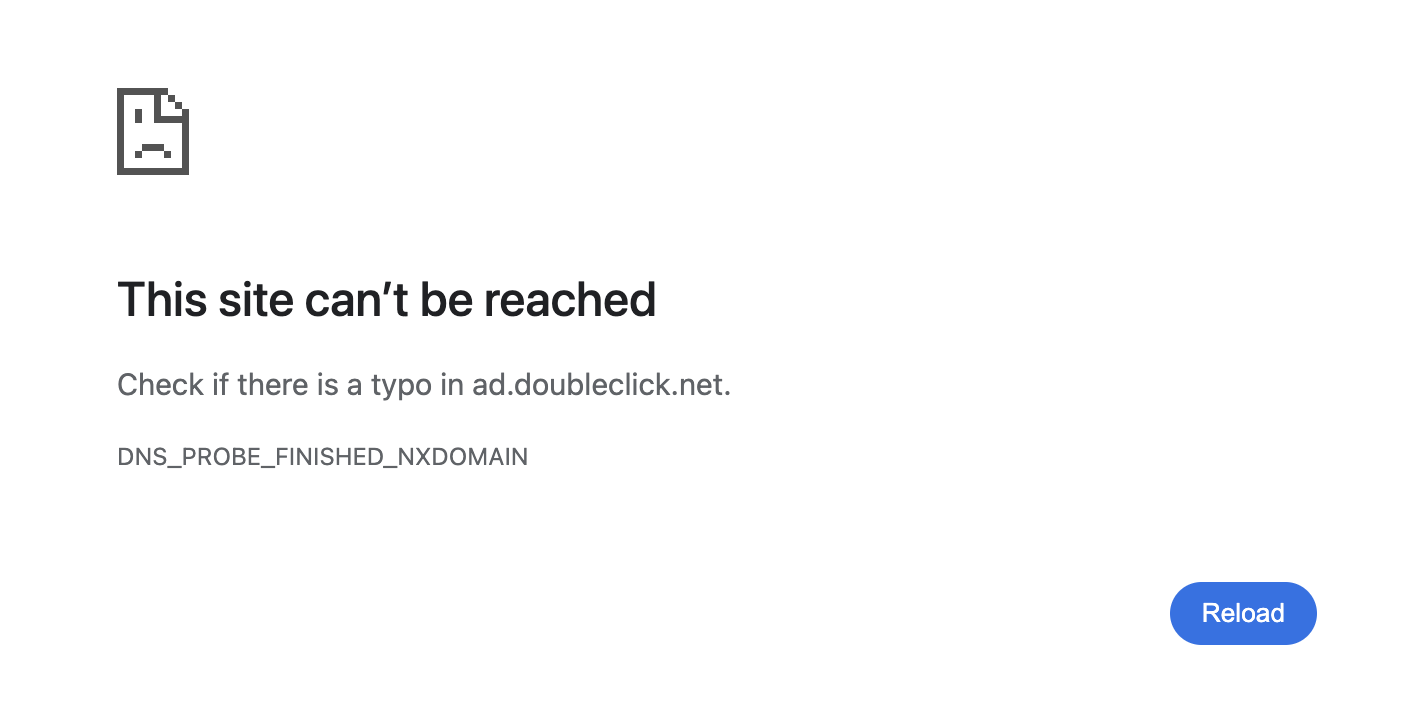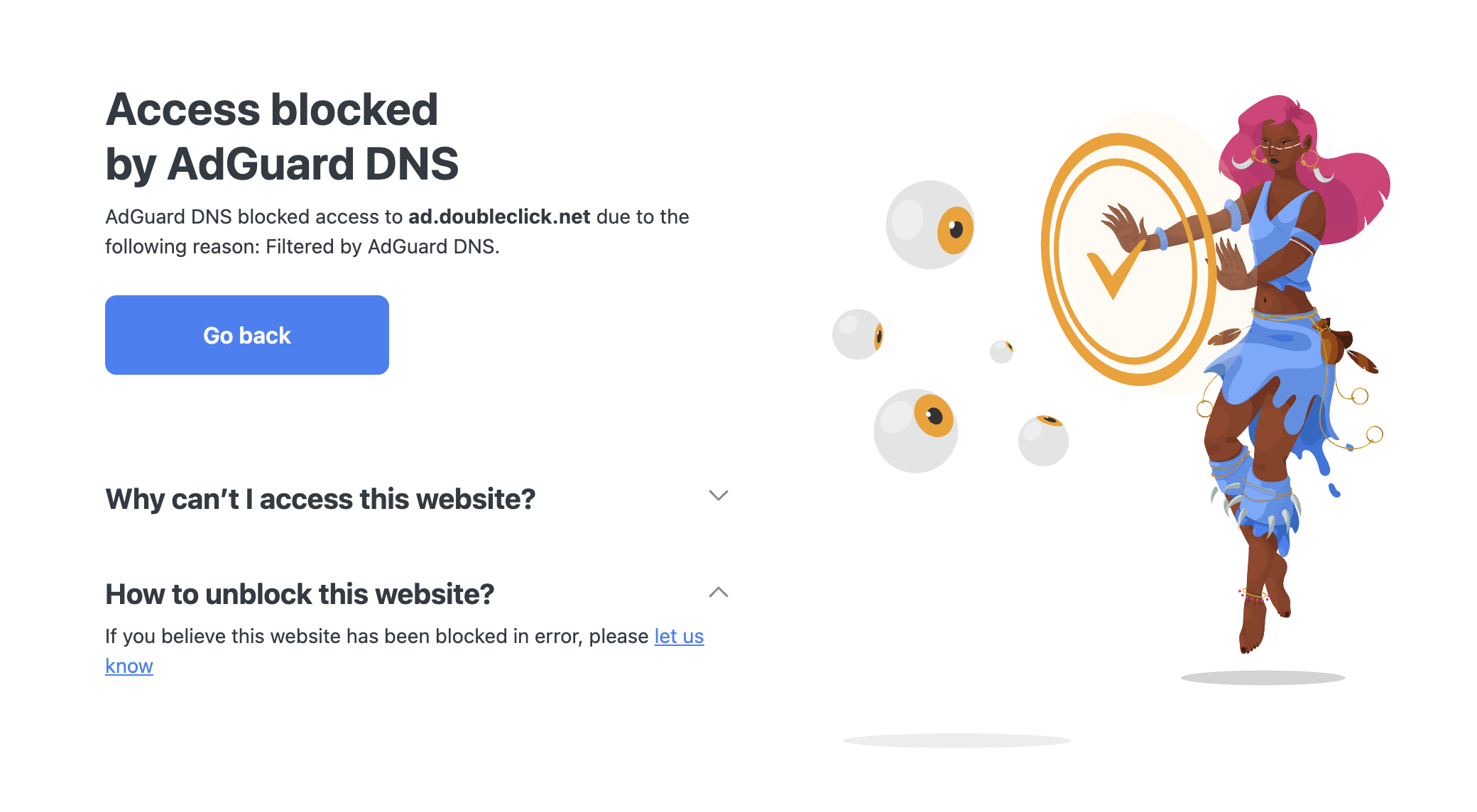Structured DNS Errors (SDE)
Com o lançamento do AdGuard DNS v2.10, o AdGuard se tornou o primeiro resolvedor de DNS público a implementar suporte para Structured DNS Errors (SDE), uma atualização para RFC 8914. Este recurso permite que servidores DNS forneçam informações detalhadas sobre sites bloqueados diretamente na resposta DNS, em vez de depender de mensagens genéricas do navegador. In this article, we’ll explain what Structured DNS Errors are and how they work.
O que são Structured DNS Errors
Quando uma solicitação a um domínio de publicidade ou rastreadores é bloqueada, o usuário pode ver espaços em branco em um site ou pode nem mesmo notar que a filtragem de DNS ocorreu. No entanto, se um site inteiro for bloqueado no nível DNS, o usuário ficará completamente impossibilitado de acessar a página. When trying to access a blocked website, the user may see a generic “This site can’t be reached” error displayed by the browser.

Such errors don’t explain what happened and why. Isso deixa os usuários confusos sobre o motivo pelo qual um site é inacessível, levando-os frequentemente a assumir que sua conexão de internet ou resolvedor de DNS está quebrado.
Para esclarecer isso, servidores DNS poderiam redirecionar usuários para sua própria página com uma explicação. No entanto, sites HTTPS (que são a maioria dos sites) exigiriam um certificado separado.

Há uma solução mais simples: Structured DNS Errors (SDE). O conceito de SDE baseia-se na Extended DNS Errors (RFC 8914), que introduziu a capacidade de incluir informações adicionais de erro nas respostas DNS. O rascunho do SDE dá um passo adiante ao usar I-JSON (um perfil restrito de JSON) para formatar as informações de uma maneira que navegadores e aplicativos clientes possam facilmente analisar.
Os dados SDE estão incluídos no campo EXTRA-TEXT da resposta DNS. Ele contém:
j(justificação): Motivo para bloqueioc(contato): Informações de contato para consultas se a página foi bloqueada por enganoo(organização): Organização responsável pela filtragem DNS neste caso (opcional)s(suberro): O código de suberro para esta filtragem de DNS específica (opcional)
Esse sistema aumenta a transparência entre os serviços de DNS e os usuários.
O que é necessário para implementar erros estruturados de DNS
Embora o AdGuard DNS tenha implementado suporte para Structured DNS Errors, os navegadores atualmente não suportam nativamente a análise e exibição de dados SDE. Para que os usuários vejam explicações detalhadas em seus navegadores quando um site é bloqueado, os desenvolvedores de navegadores precisam adotar e dar suporte à especificação preliminar de SDE.
Extensão do AdGuard DNS para SDE
Para mostrar como os Structured DNS Errors funcionam, o AdGuard DNS desenvolveu uma extensão de navegador de demonstração que mostra como Structured DNS Errors poderiam funcionar se os navegadores os suportassem. Se você tentar acessar um site bloqueado pelo AdGuard DNS com esta extensão ativada, verá uma página de explicação detalhada com as informações fornecidas via SDE, como o motivo do bloqueio, detalhes de contato e a organização responsável.

Você pode instalar a extensão da Chrome Web Store ou do GitHub.
Se quiser ver como fica no nível de DNS, você pode usar o comando dig e procurar por EDE na saída.
% dig @94.140.14.14 'ad.doubleclick.net' A IN +ednsopt=15:0000
...
;; OPT PSEUDOSECTION:
; EDNS: version: 0, flags:; udp: 1232
; EDE: 17 (Filtered): ({"j":"Filtered by AdGuard DNS","o":"AdGuard DNS","c":["mailto:support@adguard-dns.io"]})
;; QUESTION SECTION:
;ad.doubleclick.net. IN A
...